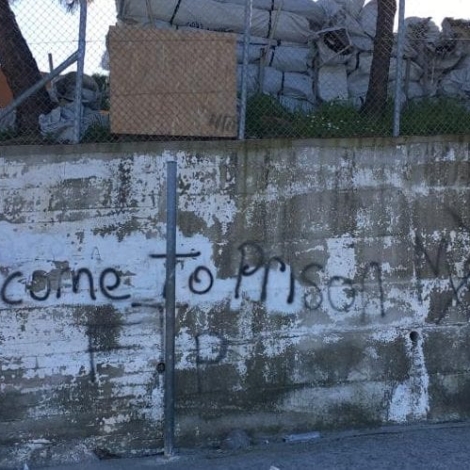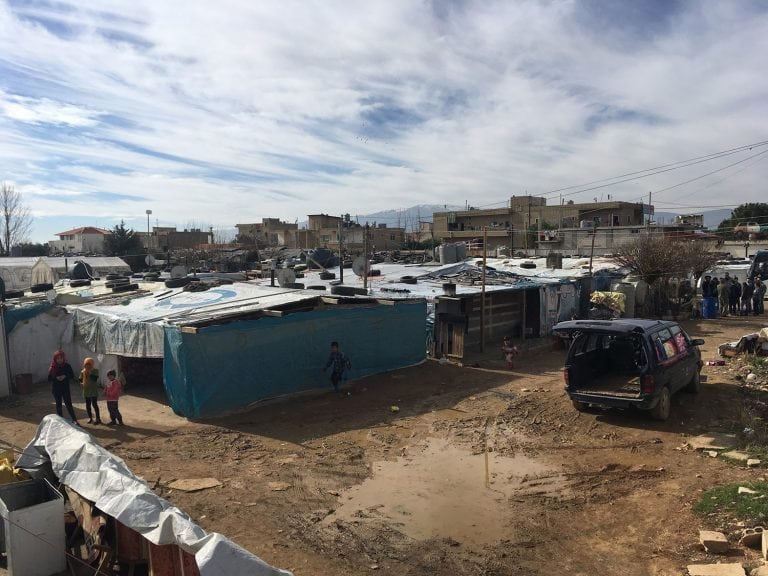I volunteered in the Moria Refugee Camp in Lesvos, Greece in March 2018. Serving as a field interpreter, I was on call with the search-and-rescue team responding to boat landings at night. The refugees who arrived at the camp had faced harrowing journeys to cross the sea from Turkey to this island, many risking their lives on plastic boats. Even the devastating stories I had heard before arriving at Moria could not prepare me for what I witnessed. The refugees were trapped, traumatized, and far from the future they sought to build. Driving to the camp on the first day, I saw dystopian graffiti on a cinderblock wall. “Welcome to prison.”
I began to reflect on ways that new technologies could alleviate the unfathomable nightmares at these camps.
I had visited refugee camps in Lebanon, where I’m from originally, but I had never before seen such poor living conditions. Moria had a capacity of 3000 people, but currently there are 14,000 refugees and migrants from 58 nations living there—1000 of whom were unaccompanied minors seeking asylum. Most of them were living in plastic tents. The toilets and showers were filthy, and the crowded queues to the bathrooms were unthinkable; water was only available every two hours. The queue for food would last hours, causing fights especially when people could not be served. Fights would break out after dark, too, spurred by longstanding sectarian conflict. And the winters were especially cruel since unheated tents could not effectively protect from rain and snow. The camp’s death rate increased during the winter months.
The result of extremely cramped living conditions is less food, improper healthcare, and poor hygiene. Moria was supposed to be a “reception center,” never a place to call home. It’s important to keep in mind that this is one example of many camps that have similar challenges.
The experience prompted the thought that I and others in my profession could make a difference among the people I volunteered with. My background is in engineering, and I began to reflect on ways that new technologies could alleviate the unfathomable nightmares at these camps. What follows are two ideas for research into technological innovations that I believe are needed to improve the quality of life in refugee camps. To anchor the list in reality, I’ve mined the Engineering for Change Solutions Library and website for examples of existing products and services that could suffice, or that could be modified to serve in refugee camps.
Neonatal monitoring devices
Doctors periodically circulate the grounds to check children for sickness, but their work is becoming increasingly difficult. With the rising number of refugees worldwide, the bandwidth of deployable doctors is strained. As a consequence, illness spreads and camp fatalities mount. Newborns and their worried parents occupy a great portion of the medical staff’s time, even when there is nothing medically wrong with the baby.
In this context, there should be a device that generates medical reports of babies’ health vitals—a device that families can safely use without needing highly coveted doctors. In the form of a bed or crib, this device could scan and measure babies’ height, weight, head circumference, and heartrate. With this level of health screening, in the absence of overworked refugee camp doctors, families would be granted peace of mind with healthy results or the ability to flag urgent care.
There is existing technology that could accomplish something like this, either as is or in some modified form. The E4C Solutions Library includes the following neonatal technologies:
- Bempu TempWatch—a bracelet that uses a sophisticated algorithm to identify hypothermia from continuous temperature measurement at the wrist of a newborn
- Neopenda—a sensor integrated into a newborn’s hat that measures key vital signs
- ChARM—a battery-powered breathing rate monitor designed to help with the diagnosis of pneumonia and reduce related childhood deaths
Incentives for garbage clean-up and recycling
Beyond health screening, most refugee camps face a garbage crisis because of overcrowding. This is not merely a political problem; it’s a public health disaster that severely affects the environment. To that end, Clean the World, a nonprofit dedicated to reducing global waste emissions, is working to clean up garbage in refugee camps around the world. Their project aims to develop devices that encourage people to manually sort waste by rewarding them with money or vouchers for food, supplies, etc. Incentive-based recycling is an intuitive way to motivate recycling among a population who will otherwise suffer under the alternative.
Incentives for recycling are not new. As E4C reports, the social enterprise WeCycle has built its business model around payments to people in impoverished communities in Lagos, Nigeria, rewarding them for recycling their trash.
Ideas needed
We know that engineering changes the world. It’s well beyond time to make structural changes for some of the most vulnerable in the world. If you have ideas on how to do so, please leave them in the comments below, or contact me at maya.reslan@live.com.
About the Author
Maya Reslan graduated from the Lebanese American University with a Bachelor in Mechanical Engineering in December 2015, then moved to Germany to pursue her Masters in Management and Engineering in production systems. Upon graduation, Maya concentrated her career in the production industry, and is now working in the Lean and Six Sigma areas. Maya is passionate about volunteering, traveling and experiencing new cultures.
This article was edited by Aaron Weinerman, Global Public Affairs Manager at the American Society of Mechanical Engineers.


Community Kitchens and Community Washing of Clothes this will save both food and water . The cooker will preferable be solar power and will keep cooking the whole day.